Mahabharata is one of the ithihasas of our country. It depicts the events culminating in the Kurushektra war that happened between the forces of dharma (the Pandavas) and adharma (the Kauravas). Though it occurred during the close of Dwapara yuga, its lessons are valid even now. Bhishma, one of the chief protagonists, took a vow of lifelong celibacy. He was a virtuous person and had the blessing to determine his time of death. Though the Pandavas defeated him in the Kurushektra war on the 10th day itself, he chose to postpone his time of death till after the onset of uttarayana (the northward course of the sun), many days after the war ended. The exact details of Bhishma nirvana can enlighten us on the Hindu luni-solar calendar that our ancestors followed during the times of Mahabharata.
Mahabharata describes various astronomical observations on the days leading up to the war and beyond. It also gives calendric details. Hindu calendar is a luni-solar calendar, which means both solar phenomena and lunar months are taken into account while devising the calendar. Let us now examine the astronomical details of Bhishma nirvana, in depth.
Table of Contents
Bhishma nirvana
The very purpose of life is to realize that it is all an illusion (maya). Human souls incarnate again and again (reincarnation) till they attain enlightenment. The enlightened souls will no longer have to be born again in this physical world, and this is termed nirvana or mukthi.
The means to attain nirvana
It is intriguing as to why Bhishma waited for so long to shed his mortal body. The answer may be found in Bhagavad Gita, which, in itself, is a part of Mahabharata. In chapter 8, verse 24, shri Krishna says:
अग्निर्ज्योतिरहः शुक्लः षण्मासा उत्तरायणम् ।
तत्र प्रयाता गच्छन्ति ब्रह्म ब्रह्मविदो जनाः ৷৷8.24৷৷
Agnijyotirahah shuklah shanmaasaa uttaraayanam |
Tatra prayaataa gacchanti brahma brahmavido janaah ||
Fire, light, daytime, the bright fortnight, the six months of the Northern solstice: by following this Path, persons who are knowers of Brahman attain Brahman when they die.
Shri Krishna is explaining the way for attaining mukthi (nirvana). He mentions that if an enlightened soul departs his mortal body during uttarayana, shukla paksha, and daytime, he will attain nirvana. That is the reason why Bhishma postponed his time of death. He chose to lay on a bed of arrows awaiting uttarayana to attain mukthi rather than depart during dakshinayana and be born again in this world.
The day of Bhishma nirvana
As Bhishma lay in his bed of arrows in the battlefield awaiting the right moment to depart his mortal body, shri Krishna and the Pandavas visited him. The day of winter solstice had passed and uttarayana had begun. Bhishma says to Yudhishthira in Anushasana Parva, chapter 153, verse 28:
माघोऽयं समनुप्राप्तो मासः पुण्यो युधिष्ठिर | त्रिभागशेषः पक्षोऽयं शुक्लो भवितुमर्हति ||२८||
maagho’yam samanupraapto maasah’ punyo yudhisht’hira |
tribhaagasheshah’ paksho’yam shuklo bhavitumarhati ||28||
“O Yudhishthira, the lunar month of Magha has come. This is, again, the lighted fortnight and a fourth part of it ought by this (according to my calculations) be over.”
– K. M. Ganguly translation
Gita Press edition adds:
निवृत्तमात्रे त्वयन उत्तरे वै दिवाकरे| समावेशयदात्मानमात्मन्येव समाहितः ||
शुक्ल्पक्षस्याष्टम्यां माघमासस्य पार्थिव| प्रजापत्ये च नक्षत्रे मध्यं प्राप्ते दिवाकरे ||
Gita press edition clarifies that it was shukla paksha, ashtami tithi, and Rohini nakshatra. And surely it was after the onset of uttarayana (winter solstice).
Obvious implications of these observations
With these details at hand, lets us understand the workings of the luni-solar calendar followed then.
Sidereal lunar months
- Bhishma mentions that it is the lunar month of Magha. As Magha is one of the 27 nakshatras, the lunar months are aligned to the nakshatras and, therefore, are sidereal. They are not aligned to the seasons. This shows that sidereal lunar months were (also) in vogue then. A point to note is that Bhishma doesn’t mention Madhu or Madhava as the name of the month.
Amanta system
- He chose to depart his earthly abode on ashtami tithi (8th tithi) during the waxing phase (shukla paksha) of the Moon. This implies that seven tithis earlier it was a new moon day. If 3/4 of the lunar month remains, it should have started on a new moon day. Therefore, it shows that our ancestors followed amanta system during Mahabharata.
Nomenclature of the lunar month
- The moon was in Rohini nakshatra on ashtami tithi when he left his body. On the full moon tithi, six tithis later, the moon should have covered another 5 or 6 nakshatras; therefore, the moon must be near Magha nakshatra on the full moon day. This forms the basis for the naming of the lunar month of Magha. The lunar month was named after the nakshatra that was close to the full moon.
Testing the validity of these observations
Mahabharata war is widely believed to have occurred during 3140 BCE. We can test this on planetarium softwares using JPL DE431 ephemerides. This ephemerides allows acceptably accurate computation of the skies from 13201 BCE to 17191 CE. It is important to use this ephemerides because the computation cannot be accurate enough otherwise. Stellarium software does not use this ephemerides by default, and therefore one should download and enable this separately.
It is hard to compute the exact positions of the sun and moon in the distant past owing to the perturbations in the revolution of the earth over a long period of time. This difference in the Terrestrial Time and the Universal Time is calculated using Δt. Various values for Δt have been proposed, and the one proposed by Henriksson (2017) covers the period between 4000 BCE and 2000 CE. I have used this for computing Δt for our purpose.
An important point to note is that I have used proleptic Gregorian calendar for the dates. This just means that the same Gregorian calendar, which we use nowadays, is extended backwards in time, even before it came into use. Gregorian calendar is a solar calendar (tropical) and, therefore, is aligned to the seasons. Hence, if winter solstice occurs around 21/22 December in a given year, this would be (almost) true even 5000 years back (Gregorian calendar will be off by one day every 3216 years. Go figure!).
Also note that, by convention, 1 CE follows 1 BCE without an intervening zero year. But some softwares do not follow this convention; they introduce an intervening zero. Therefore, these softwares mention 2 BCE as Year -1. Likewise, they mention 3140 BCE as Year -3139.
Stellarium software
Using the latest version of Stellarium software (0.20.4) and the calendar plugin, when the skies are computed for the Gregorian year 3140 BCE, winter solstice occurs during the midnight of 18 December and the waxing phase of the moon. On 20 December, 3140 BCE, shukla ashtami, at 12 noon, the moon was on Rohini nakshatra (Aldebaran) as can be seen from the screenshot.
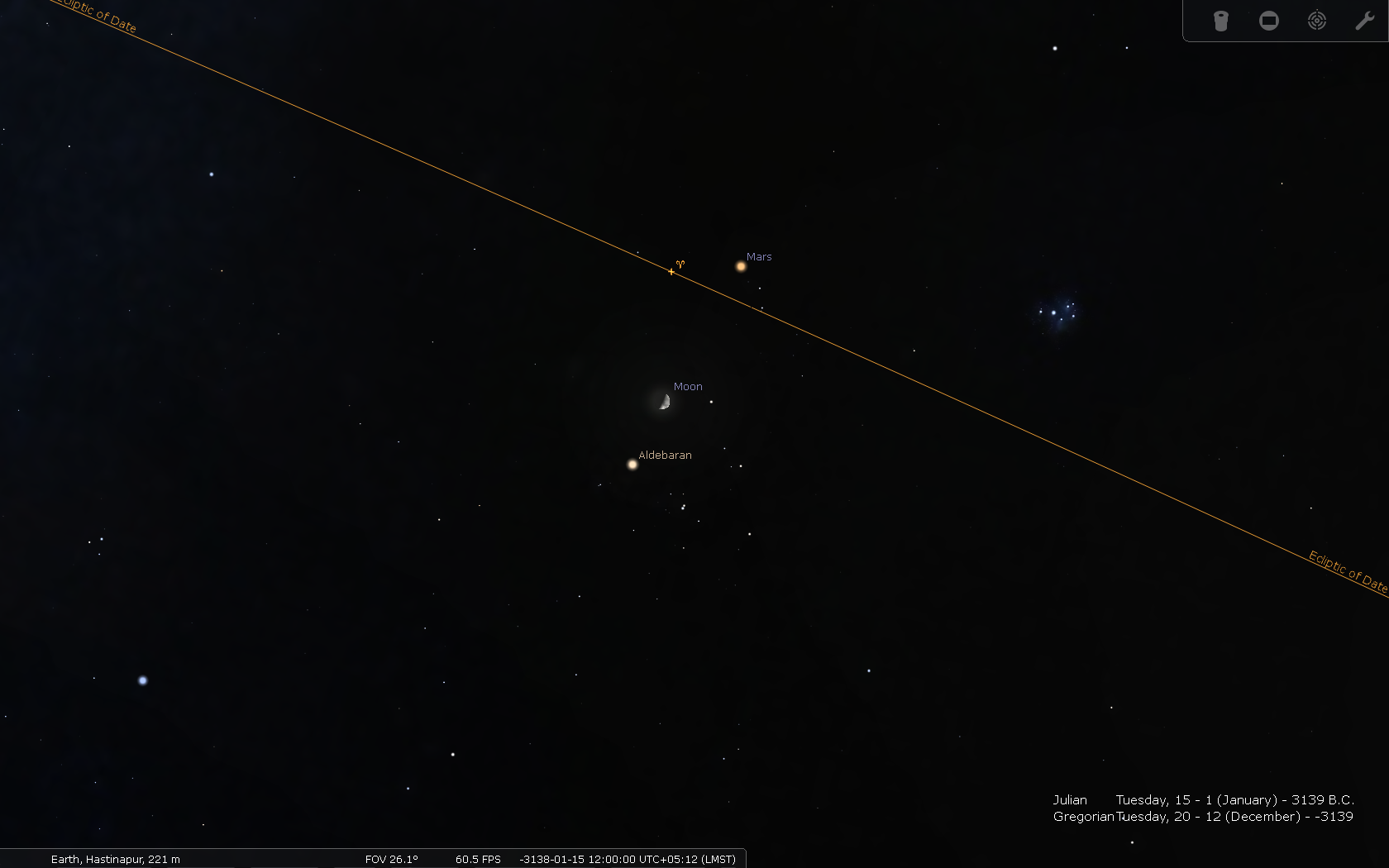
To check whether the full moon of this particular lunar month occurs near Magha nakshatra, the sky on 27 December, 3140 BCE, when full moon tithi starts has been recreated below. The moon was near Magha nakshatra (Regulus).
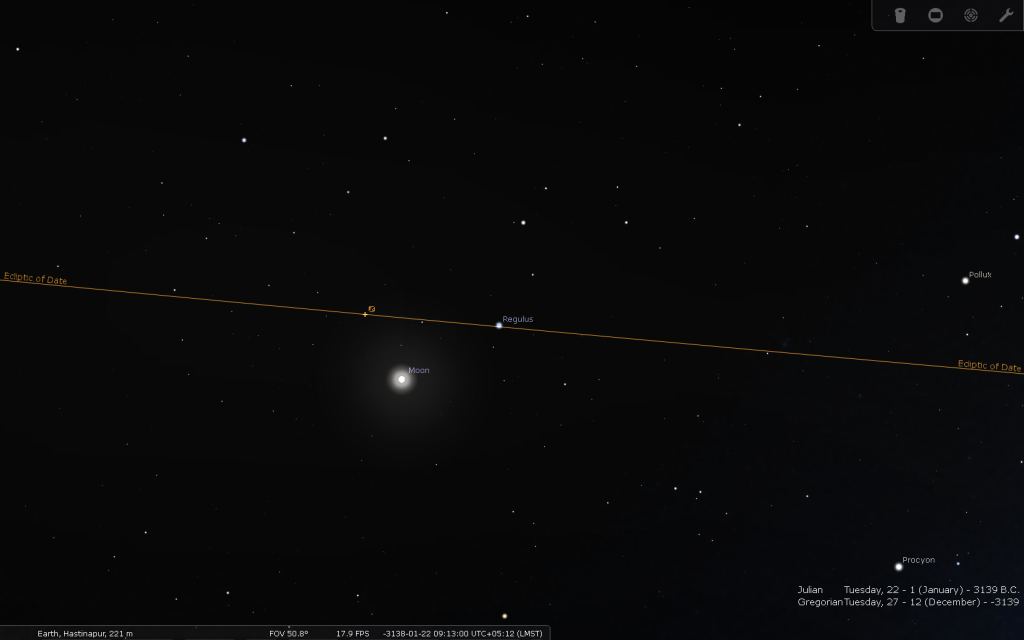
When should we observe Bhishma nirvana?
When should we observe the death anniversary of Bhishma? Common sense dictates that it should be during the lunar month of Magha and ashtami tithi on the bright phase of the Moon. May we add Rohini nakshatra too to this list, as nakshatras play an important part in the Hindu culture? Let us analyze the possibility of these criteria.
Bhishma nirvana in 2021
For the year 2021, we observed Bhishma ashtami on Saturday, February 20. During the Magha month and shukla paksha, the nakshatra and tithi on this day were:
- Shukla ashtami tithi till 01:31 PM
- Nakshatra: Rohini till next morning
All is well. This day met all the criteria. It was fortunate that Rohini nakshatra occurred on a shukla ashtami tithi in the lunar month of Magha in 2021.
Bhishma nirvana in 2022
If we calculate for the year 2022, Bhishma ashtami falls on Tuesday, February 8. The nakshatra and tithi on this day are:
- Shukla ashtami tithi till next day morning
- Nakshatra: Bharani till 21:27:09
Here, the nakshatra is Bharani. Rohini will not be the nakshatra until two days later. Should we wait for Rohini nakshatra and miss the shukla ashtami? No. It should be during the bright phase of the Moon and ashtami tithi.
Clearly, it seems that lunar tithi is more important than the nakshatras for calculating anniversaries.
What else is important, anyway
Let us list the criteria for fixing the day of Bhishma nirvana once again.
- Uttarayana (northward course of the Sun)
- Lunar month of Magha
- Bright phase of the Moon
- Ashtami tithi
- Rohini nakshatra
Of these five criteria, Rohini nakshatra during shukla ashtami tithi cannot be guaranteed every year. Can we at least guarantee the other four criteria every year, forever? Let’s give it a thought.
Bhishma mentioned that the lunar month of Magha started just before the onset of uttarayana (in December). Will this be true every year? About 5000 years hence (at present), the month of Magha occurs approximately two months after the onset of uttarayana; it occurs during February – March, nowadays. So after another 10,000 years, the month of Magha will occur during July – August (who cares?). What’s the problem with it, anyway? The problem is that the sun starts its southward journey (dakshinayana) on 21/22 June every year (and about three days later in the Gregorian calendar after 10,000 years). So it will no longer be uttarayana during the lunar month of Magha; our first criteria gets negated.
Shri Krishna to the rescue
So when should one observe Bhishma ashtami 10,000 years later? The lunar month of Magha will not occur during uttarayana at all. As usual, shri Krishna comes to our rescue. What did he tell us in Bhagavat Gita? He did mention uttarayana and the bright phase of the Moon for attaining nirvana. But, did He mention the lunar month of Magha or Rohini nakshatra? No.
Bhishma chose uttarayana and the bright phase of the Moon for the only reason—to attain nirvana. It just so happened that it was the lunar month of Magha and the nakshatra on that day was Rohini. If he were to make his choice once again, he would choose the first occurrence of the bright phase of the Moon after the onset of uttarayana. We should remember that he braved the bed of arrows waiting for the onset of uttarayana.
What will be Bhishma’s choice in 2021/2022?
The onset of uttarayana occurs on December 21, 2021, but during the dark phase of the Moon.
The next shukla ashtami is on January 9, 2022. So on this day, the two important criteria mentioned by shri Krishna are met: uttarayana and the bright phase of the Moon. But neither the nakshatra is Rohini nor the lunar month is Magha; but shri Krishna doesn’t mention either of them for attaining nirvana, and that would be the choice of Bhishma too. (In fact, he may not wait for ashtami tithi either.)
The month of Magha occurs only in February – March. Therefore, asking Bhishma to wait for one more month on the bed of arrows after he had already spent two months in the battlefield is inhuman.
We should observe the forthcoming Bhishma ashtami on January 9, 2022.
Revised Bhishma nirvana in 2022
In December 2022, the winter solstice occurs on the 22nd of that month, but during the dark phase of the Moon. The next shukla ashtami occurs on 30 December in the lunar month of Margasira (மார்கழி), and the nakshatra is not Rohini either.
We should observe Bhishma ashtami for the year 2022 on 30 December.
Summing it up
That our ancestors in the times of Mahabharata followed amanta system for the lunar months is evident from the astronomical descriptions. They named the lunar months based on the nakshatra observed during the pournami tithi. Also, as per shri Krishna, the movement of the Sun and the lunar tithis are more important than nakshatras and lunar months when discerning the timing of earthly events.
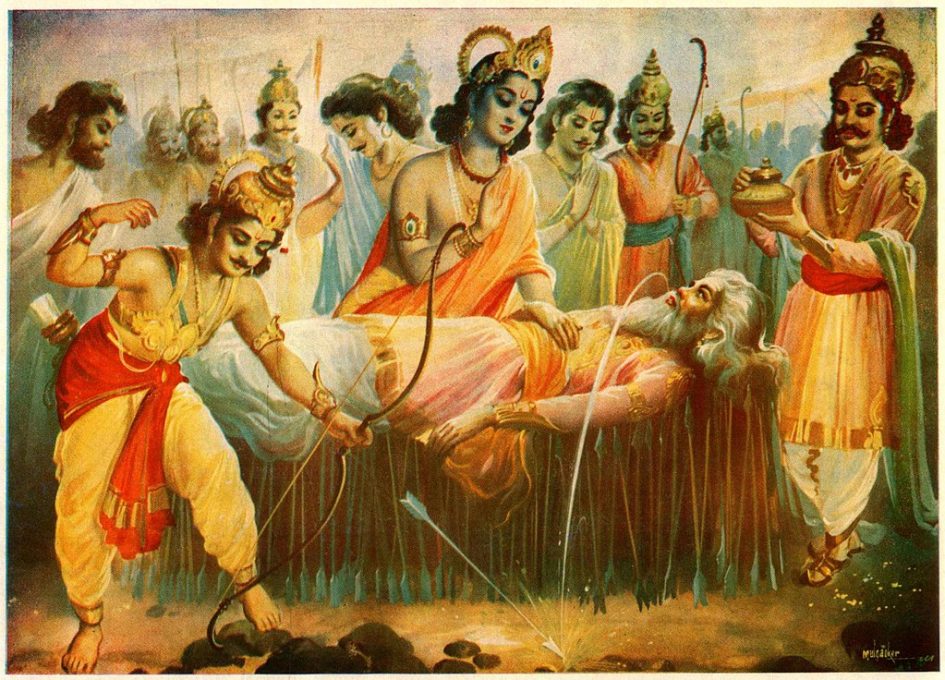
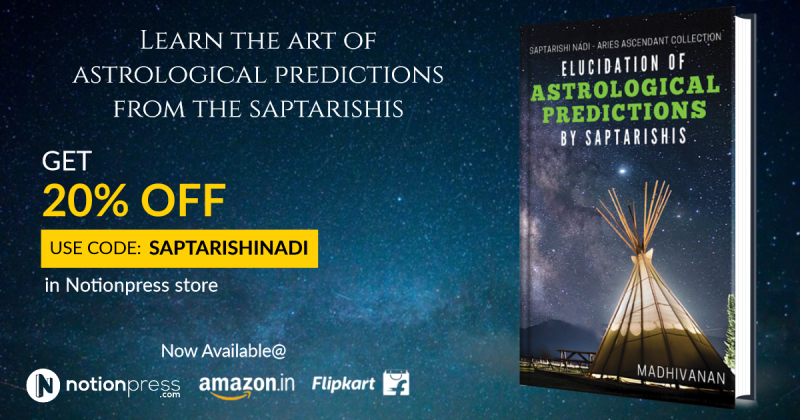
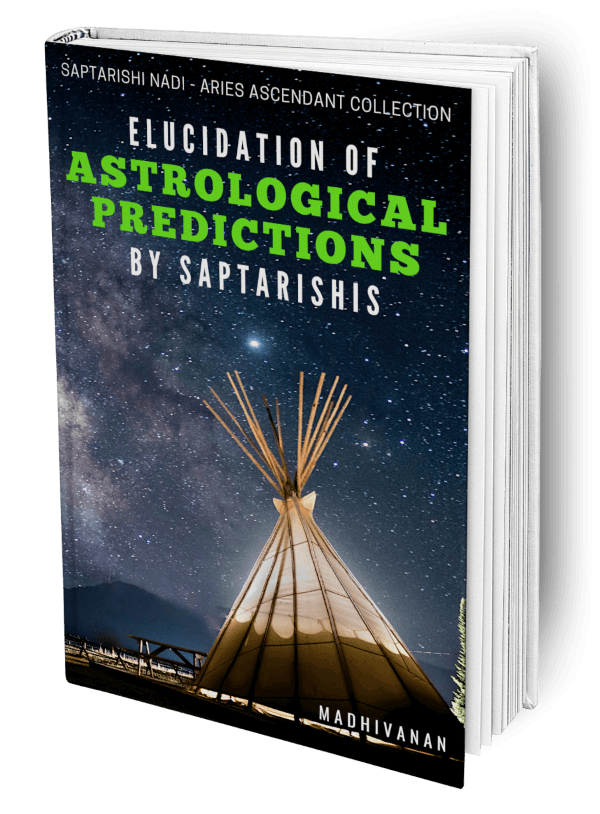
Kindly voice your views